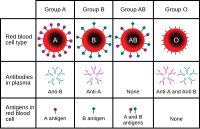
Photo from wikipedia
Objectives of this study were to analyze characteristics influencing blood donation status, to identify anxieties and reasons for (non-)blood donation, and potential channels for future blood donation campaigns. A random… Click to show full abstract
Objectives of this study were to analyze characteristics influencing blood donation status, to identify anxieties and reasons for (non-)blood donation, and potential channels for future blood donation campaigns. A random population from Germany was interviewed using the online survey tool SoSci Survey. The access link to the questionnaire was distributed via snowball system and the Bavarian Red Cross. Statistical analysis was performed to identify factors influencing blood donation status. A total of 682 participants (27.3% blood donors) with a mean age of 33.4 and a standard deviation (SD) of 12.0 years were included into the analysis. Strongest factor associated with being blood donor was having a blood donor within family and friends (Odds ratio [OR]: 5.05 [95% confidence interval [95% CI]: 2.63; 9.70]; p≤0.001), whereas having anxiety related to blood donation was the strongest factor for being non-blood donor (OR: 0.11 [95% CI: 0.05; 0.21] p≤0.001). Other factors significantly influencing blood donor status were age, health-related quality of life, knowledge on blood donation, being an organ donor and having pre-conditions. Main anxieties avoiding blood donation were fear of physical consequences, and fear of the injection needle. Most frequently mentioned channels which should be used for blood donation campaigns were Instagram and free TV. Involving blood donors into campaigns to recruit new blood donors from their personal environment and to focus campaign content on physical benefits of blood donations might help to recruit new blood donors. In addition, running campaigns stronger on channels such as Instagram might increase their scope.
Journal Title: Health and Technology
Year Published: 2021
Link to full text (if available)
Share on Social Media: Sign Up to like & get
recommendations!